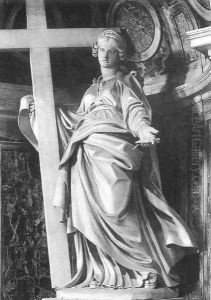Andrea Bolgi Paintings
Andrea Bolgi was an Italian sculptor of the Baroque period, born in 1605 in Carrara, a town in Tuscany famous for its marble quarries. Bolgi was trained in the robust tradition of marble carving that was a staple of his hometown's artistic production. His early life and training are not well-documented, but he likely received initial training from local masters in Carrara before moving to Rome around 1620, which was a common destination for artists seeking to advance their careers.
In Rome, Bolgi became associated with Gian Lorenzo Bernini, one of the most influential artists of his time. Bolgi worked in Bernini's workshop, where he contributed to several significant projects. Although Bolgi's work was often overshadowed by the genius of Bernini, his contributions were important in the execution of several notable sculptures and architectural projects during the period of intense artistic activity sponsored by the Catholic Church, particularly under the patronage of Pope Urban VIII.
Among Bolgi's individual works, his most recognized is the statue of St. Helena in the crossing of St. Peter's Basilica in Vatican City. Completed in 1639, this statue is part of a series that also includes works by other prominent sculptors of the time. It showcases Bolgi's ability to create a dynamic and expressive figure in the Baroque style, imbued with a sense of movement and emotional intensity. Bolgi's St. Helena is depicted in the act of finding the True Cross, which according to Christian tradition, was discovered by the historical St. Helena in Jerusalem.
Despite his talent, Andrea Bolgi did not achieve the same level of fame as his contemporaries like Bernini or Francesco Borromini. His work, however, was appreciated for its technical skill and adherence to the Baroque sensibilities of drama and expression. Bolgi's career continued in Rome, where he worked on various commissions and contributed to the grand artistic endeavors of the era.
Andrea Bolgi died in 1656 in Rome. His legacy is encapsulated in the marble statues and the contributions he made to larger projects during his career. While not a household name, Bolgi remains a respected figure among scholars of Baroque art for his skillful work in marble and for being part of the vibrant artistic environment of 17th-century Rome.
